Hazro came onto the monitor
scene pretty recently, and a fair degree of fuss was kicked up after we released
a
news article about their new all S-IPS based range of screens. We've already
taken a look at the newest model, their 24"
HZ24W, and now we have the 26" model for testing. These are the main two
screens which seem to be attracting attention at the moment, with users keen to
look for S-IPS technology in these sectors. Unfortunately there aren't many
competing screens, and those that are available (such as the NEC LCD2690WUXi)
are less affordable to the masses. This leaves Hazro with quite a niche,
certainly in the UK where the range is already available, and hopefully in the
USA later in the year where it has a planned release.
Hazro's website says the
following about the HZ26W: "Aesthetically,
ergonomically and technically astounding, the Hazro HZ26W 26”
monitor provides a breath-taking interpretation of engineering and design
excellence.
From graphics
studios to press rooms to the office floor, the Hazro HZ26W redefines the
workplace to bring visuals to life. With uncompromising resolution and
razor-sharp display, the Hazro HZ26W remains consistent across the harshest work
environments. Wherever you’re based, whatever your needs, the Hazro HZ26W sees
display technology realise perfection."
Let's take a look at the
product specs:
|
Size |
26"WS |
Colour Depth |
16.7M (8-bit), 92% NTSC colour gamut |
|
Resolution |
1920 x 1200 |
Viewing Angles |
178 / 178 |
|
Response Time |
5ms G2G |
Panel Technology |
S-IPS |
|
Contrast Ratio |
800:1 |
Interfaces |
DVI, VGA and Component |
|
Brightness |
500 cd/m2 |
Colour |
Aluminium bezel and stand |
|
Special Features |
Tilt ergonomic adjustment, touch sensitve OSD
buttons, aluminium construction, hardware aspect ratio control. 92% NTSC
colour gamut |
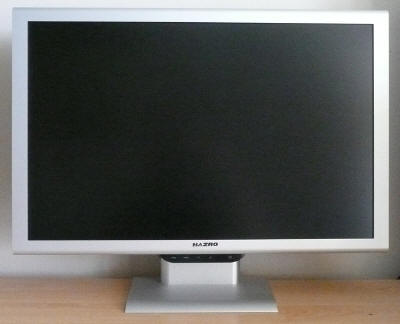
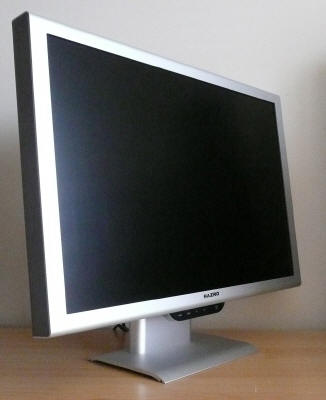
Above:
front and side views of the HZ26W. Click for larger versions
The HZ26W is ultimately very
similar to the smaller HZ24W, but this time the screen offers a 26 inch
diagonal. Hazro sent us the black aluminium version of the 24" model, but this
time we have the silver coloured regular alumium variety. The screen is
attractive to look at and of very sturdy construction. Materials are all of high
quality and build quality is excellent.
The OSD selection buttons sit
just beneath the centre of the screen and are pretty unobtrusive. On this silver
coloured model, the OSD buttons still have a black background colour, and it
would perhaps have been nicer to see a 'body-coloured' backing here. The stand
for the screen is in the same colour as the bezel, and the back of the screen
has a slightly darker casing colour.
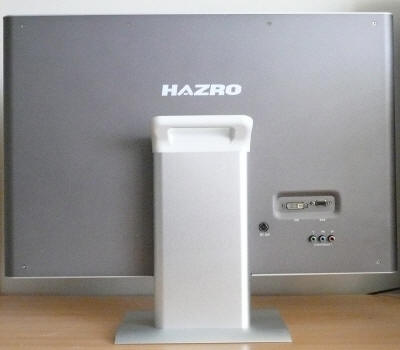
Above: Rear
view of the HZ26W showing carry handle and interface connectivity. Click for
larger version
Like the HZ24W, the screen is
totally flat at the back, and attractively contained within an aluminium casing.
There is also a carry handy at the top of the stand for transporting the screen.
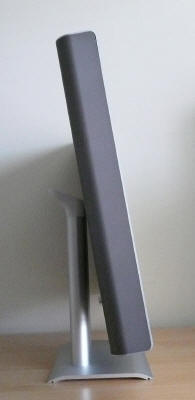
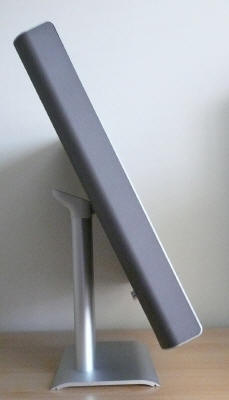
Above: Side
view showing tilt range. Click for larger versions
The screen only offers a tilt
ergonomic adjustment, but this is sufficient to position the screen comfortably
in any situation. The mechanism is smooth and the stand is sturdy enough to
comfortably support the screens weight. A height adjustable stand would have been useful I think, but
the lack of features like rotation control are at least not really an issue at this size.
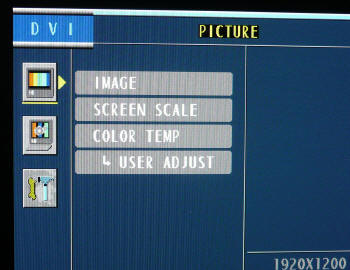
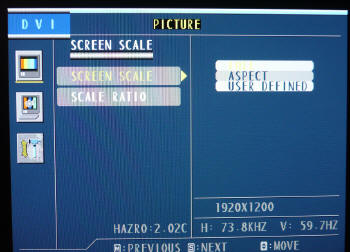
Above: OSD
options shown, including aspect ratio control on the right. Click
for larger versions
The OSD menu itself was operated using the touch
sensitive buttons under the bottom of the screen. The menu is reasonably simple
to use and features controls for colour temperature, RGB values and
brightness/contrast as one would expect. Pleasingly there is also an option for
aspect ratio control, offering options for 'full', 'user defined' and 'aspect'.
This feature is listed in the manufacturers specs and is something which many
buyers look for in a new screen. Nice to see Hazro acknowledge this feature and
incorporate it into their displays. The OSD selection buttons gives quick access
to this aspect ratio control (through the 'select' button), and also to
interface options (VGA, component and DVI being available). Oddly, the only
slight 'glitch' with the OSD was that when altering the values for brightness
etc, the up and down arrows as shown on the buttons themselves appear to be the
wrong way round. Not major at all, and at least they move you the right way
through the main OSD selections.
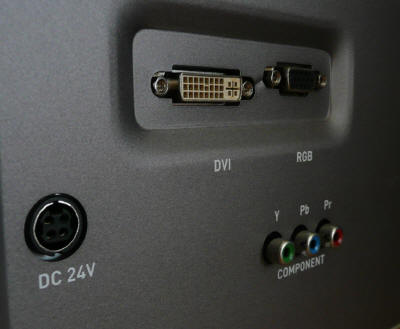
Above:
Interface connectivity options. Click for larger version
The back of the screen offers interface options
for DVI, VGA and RGB component (Y / PB / Pr). Certainly handy for connecting
multiple sources including games consoles. The power connector is not the normal
kettle lead type, and so you need an external power brick (provided of course)
with this screen. It might have been nice to see a cable tie on the back of the
stand but it's still reasonably easy to tuck the cables out of sight.
As you would expect, the screen is Vista ready and
features a power-save mode when not in use. The screen is VESA compliant (100mm
x 100mm) and comes packaged with power and DVI cables. The aluminium finish is
non-reflective and the materials all feel of a very high standard. Build quality
is very good, and overall the screen looks impressive. The panel itself is a
matt finish with anti-reflective coating being used (3H hard coating).

Colour Quality and
Accuracy
The Hazro HZ26W utilises an 8-bit S-IPS panel,
capable of producing a true 16.7 million colours. The screen uses enhanced W-CCFL backlighting and so it's colour gamut covers
92% of the NTSC colour space.
An
important thing to consider for most users is how a screen will perform out of
the box and with some basic manual adjustments. Since most users won't have
access to hardware colorimeter tools, it is important to understand how the
screen is going to perform in terms of colour accuracy for the average user. I
restored my graphics card to default settings and set it to its standard
profile. The HZ26W was tested at default factory
settings out of the box using the
LaCie Blue Eye Pro and their accompanying software suite.
Default settings of the screen were 68 brightness and 68 contrast. Colour
temperature mode was set to 6500k (this resulted in RGB control being greyed
out) and the 'image mode' was left on 'user'.

Hazro HZ26W - Default Settings
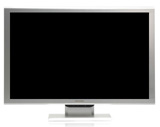
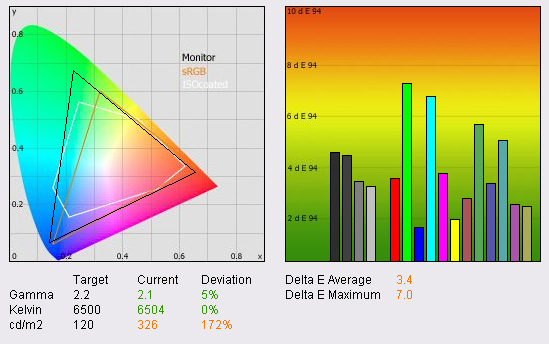
|
|
Default Settings |
|
luminance (cd/m2) |
326 |
|
Black Point (cd/m2) |
0.61 |
|
Contrast Ratio |
534:1 |
Out of the box, the
performance of the HZ26W at default settings was only average. On the left
hand side of the above image you will see the familiar
CIE diagram which shows
that the monitors colour gamut, represented by the black triangle. This fits outside the
standard sRGB colour space represented by the orange triangle. This goes to show that the screen is using
wide-colour CCFL backlighting and can offer a 92% coverage of the NTSC colour
space as the specification lists. To the eye, the colours do look a little
deeper and more vivid, particularly in green shades. This is also evident in
the CIE diagram where the monitors triangle stretches outside the sRGB space
most in green shades.
Below this you can see the
reported measurements for gamma, colour temperature and luminance in turn. The
monitors gamut at default setting is fairly accurate at 2.1, being only a
little way out from the desired 2.2; this being the
default for computer
monitors, and the standard for the Windows operating system and the
Internet-standard sRGB colour space. The screens preset colour temperature
mode was left on 6500k as default, and this actually resulted in an excellent
colour temperature reading of 6504k, almost spot on. Luminance on the other
hand was far out from the desired 120
cd/m2, being the recommended setting for LCD screens in normal
lighting conditions. This was recorded at a very high 326 cd/m2.
With black depth being measured at a pretty poor 0.61 cd/m2 this
gave a static contrast ratio of 534:1, a little way out from the specified
800:1.
Despite the
overly bright initial settings, the colours did not appear to be too washed out
or uneven. They felt well produced to the naked eye really, and were even and vivid,
especially in green shades.
Testing with the colorimeter revealed the graph on the right hand side above,
showing DeltaE (dE 94) values across 16 shades.
As a reminder, the lower these bars down the Y-axis, the better, in terms of
colour accuracy. For reference, LaCie describe the DeltaE readings as:
-
If DeltaE >3, the color displayed is significantly different from the
theoretical one, meaning that the difference will be perceptible to the
viewer.
-
If DeltaE <2, LaCie considers the calibration a success; there remains a
slight difference, but it is barely undetectable.
-
If DeltaE < 1, the color fidelity is excellent.
The default colour accuracy
was pretty average really, and goes to show that you can't just rely on the
often quoted addage, that S-IPS screens are automatically great for colour
quality. DeltaE was on average only 3.4, and ranged up to 7.0 as a maximum.
Clearly a degree of calibraiton would be required if you wanted to use this
screen for any colour critical work, such as graphics or photography.

Hazro HZ26W - Calibrated Settings
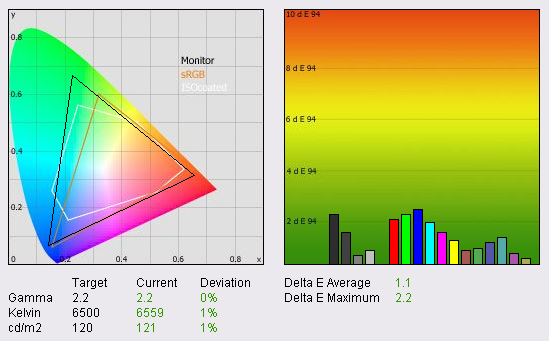
|
|
Calibrated Settings |
|
luminance (cd/m2) |
121 |
|
Black Point (cd/m2) |
0.56 |
|
Contrast Ratio |
218:1 |
I calibrated the screen using the LaCie Blue Eye Pro package to see what the
screen was capable of with professional configuration and profiling. During this
process the screens OSD settings were altered to 44% brightness and with
contrast left at 68%. I used the 'user' colour preset mode which afforded me
access to the individual RGB colour channel controls. These were set to 54, 41
and 50 respectively during the process.
It should be noted that this adjustment only forms part of our calibration
process, and the majority of the changes occur at a LUT and ICC profiling level, as an automatic
process altered by our colorimeter.
Gamma was now corrected to 2.2 and luminance to
121 cd/m2 as we hoped. Colour temperature remained very good at
6559k, being ever so slightly out from the desired 6500k level. With the amended
luminance value we now had a slightly improved black depth of 0.56 cd/m2,
still being pretty poor compared with other panel technologies and even the 24"
HZ24W model (0.38 cd/m2). This gave a pretty weak contrast ratio of
218:1. I tried several different brightness settings via the OSD to see if
recalibration could help improve this black depth. There was very little change
and it was not possible to improve the black point beyond about 0.55 cd/m2.
Colour accuracy was however corrected very
nicely, and dE was on average now only 1.1. LaCie would consider colour fidelity
to be pretty much excellent, on average, with the HZ26W. There was some slight
discrepencies in some shades, particularly the main red, green and blue colours,
but dE was only 2.2 at its maximum, leaving a barely detectable difference
between requested and displayed colours in LaCie's classification. Overall the
calibration proved a success, with only black depth being a little disappointing
here. S-IPS panels are certainly capable of some decent colour accuracy, but
calibration is often needed to get the best results. It should be noted that
other panels we have tested have offered even better results in terms of dE
values, but the HZ26W still performed admirably and should be suitable for
colour enthusiasts and those who need reliable results in their photo and
graphics work. Testing the screen with colour gradients showed no banding or
obvious gradation.

Viewing Angles
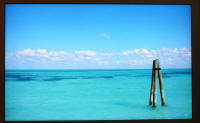
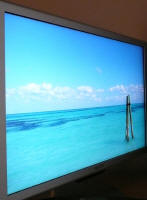



Above: Viewing
angles shown from front and side, and from above and below. Click for larger images
Viewing angles from S-IPS panel technology are widely considered to be the best
in the LCD market and the HZ26W offered excellent fields
of view in all directions. Vertically, the panel showed none of the very obvious
contrast shift, or blackening from below, that you see from TN Film based
models. Horizontally, the angles were wide, but you could detect a slight
characteristic purple and blue tinge as you reached angles of about 45° away from the
perpendicular. In pratice, the
viewing angles of this screen were comfortable for a wide range of uses, and
also were free from the off-centre contrast shift anomaly which you can see from
VA based matrices. This is commonly the reason that S-IPS is selected as the LCD
panel technology of choice for colour critical work, since the viewing angles
are wide and free from this contrast shift you can see from VA matrices.

Panel Uniformity
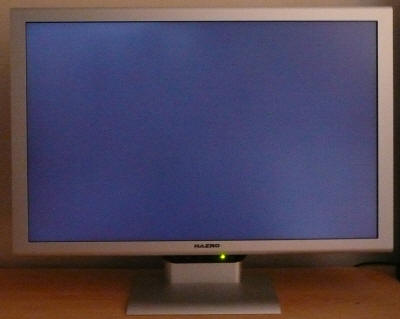
In our usual testing process I viewed an all black
screen in a darkened room, which allowed me to test the uniformity of the panel
and to examine whether any backlight bleed was evident. There was very little
detectable leakage from the backlighting, and the uniformity remained very
consistent across the whole screen. The image shows some slight variation
towards the corners, but this was far less noticeable in practice to be honest.

Office and Windows Use
The extra screen real
estate that a 26" model offers you over a 24" model does not feel that much to
me, but then day to day I tend to use 24" models anyway. If you're coming from a
smaller screens, the sheer size of this screen will astound you! The screen
does only offer a 1920 x 1200 resolution which is only equal to that of 23 and
24" models. This results in a slightly larger pixel pitch of 0.2865mm, meaning
text appears a little larger than on a 24" model with 0.270mm pixel pitch.
However, this feels a nice comfortable size for prolonged office work, and many
people may find it a little easier on the eyes than the 'tighter' pixel pitch of
the smaller screens. The pixel pitch is quite comparable to 19" and 22" models
in the market as well.
For office use, the
large screen size and resolution make side by side working a treat, and you can
easily split the screen down the middle for two word documents to be visible at
the same time. I think you need a resolution horizontally of this size to really
make the most of this feature, and the HZ26W is very good to work with here. The
screen offers both VGA and DVI interfaces, with the latter offering a slightly
sharper image quality. Use the pure end-to-end digital interface if you can.
There are no preset profile modes offered from the screen such as "text" or
"internet" which you commonly see on other models, but once calibrated to a
comfortable luminance, the screen was perfectly fine for prolonged use anyway,
even in low light conditions. You will need to adjust the luminance of the
screen considerably from the default value since it is a long way off at factory
settings. If nothing else, drop the brightness OSD setting down from 68 to 25.
If you have a colorimeter, further, more accurate calibration is desireable.

Responsiveness and Gaming
The Hazro HZ26W was tested using the chase
test in PixPerAn, a good bit of software for trying to quantify differences in
real terms responsiveness between monitors. As a reminder, a series of pictures
are taken on the highest shutter speed and compared. The images below show the
best case example on the left hand side, and the worst case example on the right
hand side. This should only be used as a rough guide to comparative
responsiveness but is handy as a way of keeping a constant test of each screen.


As you can see from the above images, the HZ26W
offered quite similar performance to its 24" counterpart, the HZ24W. There was a
slight ghosting detectable in the 'best case' image, and a more obvious second
ghost identifiable in the 'worst case'. In practice, the performance was
actually very good, and certainly a step up from non-overdriven panels in the
market. The naked eye could barely detect any ghost images, just a blurring of
the moving car.
The HZ26W offers a 5ms G2G rated response time
from it's S-IPS panel, manufacturered by LG.Philips. This indicates that
Response Time Compensation (RTC) technology is being used here (or an ODC -
Over Driving Circuit as LG.Philips refer to it) , and this is evident from
our tests. For an S-IPS panel, which are historically quite unresponsive, the
HZ26W performs well.

Pitting the screen against our reference monitor,
the NEC 20WGX2 (also S-IPS based), we can see the performance is slightly
behind. The difference is not massive, but the NEC is widely regarded as one of
the fastest LCD screens in the market today, and the HZ26W can't quite keep up.
The HZ26W was pretty comparable to the overdriven 24" models we have tested in
the past as well, including the Dell 2407WFP-HC (6ms G2G S-PVA) and Viewsonic
VX2435WM (8ms G2G S-MVA) for instance. In games you can expect to see some
motion blur if you know what to look for, but all in all the response time is
more than adequate for some pretty decent gaming. If you want to invest in a big
screen, and don't want to make the sacrifices of TN Film, the HZ26W can still
offer you good performance in terms of responsiveness.
One other thing to bear in mind is that you will
need a pretty powerful graphics card to run this screen at its full 1920 x 1200
resolution in modern games, especially if you want details and eye candy turned
up high. The screen does feature hardware level
aspect ratio control which is nice to see, and good to see Hazro have even
listed this feature in their specification on the website. This is a positive
up-front approach which consumers should be glad to see. This aspect ratio
control offers options for 'user defined', 'aspect' and 'full', allowing you to
play 4:3 and 5:4 aspect sources (games, external devices etc.) without the
screen always stretching the image horizontally.
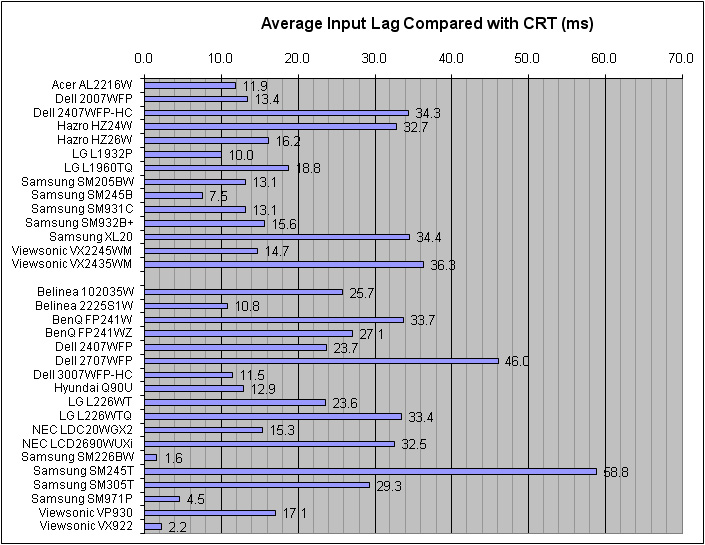
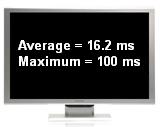

As usual I tested the
screen in clone mode with a CRT to determine the level of input lag. This is
something which can put off some gamers and is a delay between graphics card and
monitor output. By hooking up a CRT you can show that the LCD lags behind
somewhat, which can affect users in some situations where they rely on the
screen image being as fast as their inputs (e.g. fast FPS shooting games).
Often, input lag is very low and probably wouldn't represent too much of a
problem in real terms.
The above graph shows that average input lag
was 16.2ms on the HZ26W. Commonly the lag was 10 - 20ms, but there was the odd
image which showed a lag of 100ms. This was infrequent however and didn't impact
on the average lag much. In practice I doubt many users would see any adverse
affect of the input lag here.

Movies and Video

When determining whether a display is well suited
for movies, you need to consider a few things:
-
Screen real estate is becoming increasingly
important in todays market, with LCD TV's becoming widespread and desktop
monitor size on the up. The HZ26W is obviously a 26" screen diagonal and so well
suited to viewing video and movie content. The size makes it a nice screen for
combined desktop and multimedia use.
-
The 1920 x 1200 resolution offered here means that
a true 1080 HD resolution can be displayed, without the need for the screen to
downscale at all. A 20 - 22" model can't quite offer the resolution (you need at
least 1920 x 1080 for 1080 HD), but the HZ26W can. If you intend to view HD
material, the resolution here is fine.
-
HDCP
support over a digital interface is vital for viewing HDCP encrypted content.
Unfortunately the DVI interface does not offer this. This could prove a
potential problem if you ever intend to watch Blu-ray or HD-DVD (or other
encrypted content) on the screen.
-
Interface options are important if you plan to use
the screen with external devices. The HZ26W offers DVI, D-sub and component. The
latter of which could well be handy for connecting DVD players or games
consoles. It might have been nice to see
an additional HDMI port included as well, something which is becoming more
common on larger screens nowadays.
-
Viewing angles should be wide, and thanks to the
use of S-IPS panel technology, they are.
-
Black depth should be good. Sadly the black depth
on the HZ26W is pretty poor, with a calibrated black point of 0.56 cd/m2
being a little disappointing. In darker scenes this can mean detail is hard to
pick out, and it can be difficult to seperate between dark grey tones.
-
Uniformity should be good, since uneveness becomes
very apparent in dark movie scenes and in low light conditions. Thankfully
uniformity was good here, and the screen was free from any annoying leakage
along the top and bottom of the screen, something which can be particularly
frustrating in DVD's with black borders.
-
Movie
noise must be kept to a minimum, otherwise artefacts and twinkling in large
colour masses can be noticeable. The high resolution of the HZ26W means that any
compressed or low res / SD content looks a little blocky, and any compression
artefacts are accentuated. Noise is noticeable as well, something which is
common on S-IPS panels. However,
if you sit a couple of metres away, which you'll want to with a screen this
size, there is no real issue in practice.

Conclusion
Overall the HZ26W was pretty much just a larger
version of the 24" model, with performance being pretty comparable between the
two. Thankfully I enjoyed the HZ24W and so using the larger HZ26W was also a
pleasant experience. The design of the screen is very sleak and attractive but
ergonomically it could be improved with a height adjustment. The build quality
is very good and connectivity options were pleasing. The extended colour gamut
that the 26" model offers is a nice addition and does help improve the colours
on the screen. Sadly black depth let the screen down and is pretty poor, even
for an S-IPS panel. Apart from this, there were no real issues with the screen,
and it offered decent colour accuracy once calibrated, wide viewing angles and
good responsiveness. The screen currently retails for around £556 in the UK,
making it a reasonably affordable option compared with some of the competing 26"
non-TN Film models.
|
Pros |
Cons |
|
Good colour accuracy after
calibration and S-IPS panel technology |
Pretty poor black depth from
S-IPS panel |
|
Wide viewing angles, and free
from off-centre contrast shifts of VA panels |
Limited ergonomic adjustments
from the stand |
|
Good responsiveness and low
input lag |
Default colour accuracy only
average |